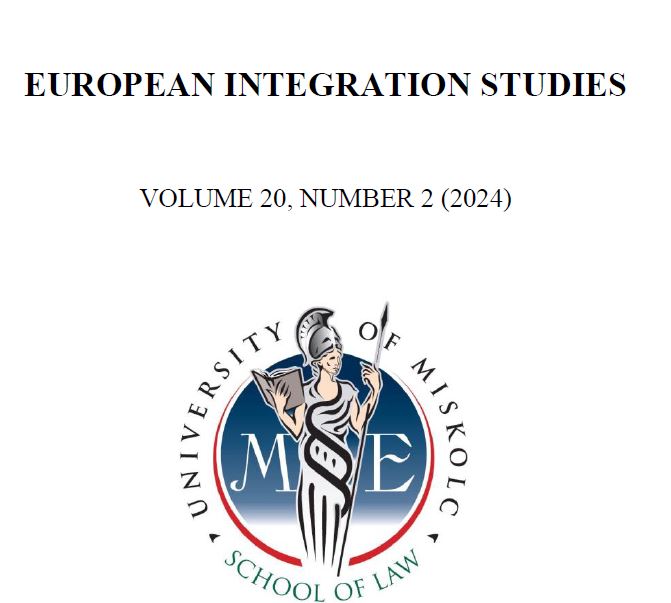Constitutional and European legal rules for armaments’ quality and presentation of alternative procurement: Contribution to the possibilities of contractual optimisation in armament procurement (the contract as a force multiplier)
DOI:
https://doi.org/10.46941/2024.2.2Keywords:
Armament – Constitutional obligation for optimized armament, Fundamental rights of soldiers, Optimized modes of procurement, VAT optimization modes.Abstract
- War is a legally relevant hazardous situation with potentially incalculable human casualties in terms of life and limb, especially of the soldiers in action. This dangerous situation is comparable to a nuclear power plant meltdown.
- Many European states have a constitutional obligation (not examined in detail). For example, the Federal Republic of Germany and Austria must qualitatively optimise armament for the purpose of protecting the fundamental rights of soldiers who may be fighting.
- This obligation exists throughout the EU based on the CFR and the jurisdiction of ECHR, in the rank of ordinary statutory law.
- Armament procurement is also a legal subject for multidimensional optimisation under numerous legal aspects, in particular the choice of contract type, price optimisation, and tax optimisation. Therefore, it should (finally) be considered multidimensionally for the benefit of the defence of freedom in EU-Europe and NATO as a whole.
- The procurement of defence equipment must contractually enable the core objectives of the state, namely secure availability, sustainable defence equipment, and cost-effective procurement. To this end, hundreds of individual contractual clauses and regulations must be used.
- Rental and leasing contract procurement is generally more cost-effective and otherwise offers no disadvantages compared to traditional purchase procurement. All conceivable disadvantages can be contractually prevented and avoided. Specific unavoidable disadvantages are practically not recognisable. It is a suitable “force multiplier and defence enabler.”
- Optimised contractual arrangements, particularly other contract types and VAT optimisation, can save at least tens of billions of euros per year in the whole EU-Europe.
- Due to the lower impact on the annual budget, more and/or better quality of armaments can be procured.
References
Anand, V. (1999) ‘Impact of Technology on Coduct of Warfare in Strategic Analysis’. A Monthly Journal of the IDSA, 23(1). [Online]. Available at: https://ciaotest.cc.columbia.edu/olj/sa/sa_99anv02.html (Accessed: 16 January 2025).
Bortz, J., Döhring, N. (2002) Forschungsmethoden und Evualation für Human und Sozialwissenschaftler. 3rd edn, Springer.
Bunjes, J. (2018) UStG-Kommentar. 21. Edn, Munich: C.H. Beck.
Cadieu, T., Adams, J. (2010) ‘Der Kampfpanzer Leopard 2A6M in Afghanistan‘, Das Schwarze Barett, 10(43).
Clement, R. (2012) ‘Sicherheitspolitik in Europa vor dem Hintergrund der Euro-Krisen‘, Der Mittler Brief, 3.
Dietlein, J. (2022) Allgemeines Polizei- und Ordnungsrecht. 16th edn. Munich: C.H. Beck.
Dupuy, T. N. (1980) The Evolution of Weapons and Warfare. Indianapolis, Indiana: Bobbs-Merrill Co.
Edenfeld, S. (2009) ‘Die Fürsorgepflicht des Arbeitgebers bei Auslandseinsätzen‘, Neue Zeitschrift für das Arbeitsrecht, 09(17).
Gedeon, M. (2019) ‘Sparsame Sportveranstaltungen im antiken Rom und heute‘, in Valdár, V. (ed) Perpauca terrena blande honori dedicata (Gedankenschrift für Peter Blaho zum nicht erlebten 80. Geburtstag), Trnava: Trnavská Univerzita, pp. 157-165.
Geiger, T., Khan, M., Kotzur, S. (2017) ‘Anhang 1 Grundrechte-Charta, Einführung‘ in EUV-AEUV-Kommentar.
Gimmler, K. H. (1998) ‘Grundlegende rechtliche Rahmenbedingungen und Gestaltungsmöglichkeiten des BW-Beschaffungswesens‘ in Finanzierungsnot der Streitkräfte, Dokumentation des Symposiums Bad Marienberg, pp. 76-87.
Gimmler, K. H., Bösch, Reinhard E. (eds) (2016) ‘Grundrechtliche Pflichten zur Gefahrenabwehr im Verteidigungs- und Sicherheitsbereich‘, in Wehrpflicht, Vienna: FPÖ-Bildungsinstitut, pp. 137-145.
Gimmler, K. H. (2017a) ‘Alternative Rüstungsbeschaffung in zivilrechtlicher Gestaltungsbetrachtung‘; ‘Miet- und Leasingmodelle für die Deutsche Bundeswehr und das Österreichische Bundesheer‘, ÖMZ, 17(2).
Gimmler, K. H. (2017b) ‘Verteidigungs-, insbesondere Rüstungsentscheidung zwischen Recht und Politik in Deutschland, Österreich und Ungarn‘, ÖMZ, 17(5).
Gimmler, K. H. (2022) Theorie und Praxis des Kontraktlogistikvertrages und verwandter Vertragsform der Logistik, zugleich ein Beitrag zur Best-Practice Gestaltung von langfristigen Wirtschaftsverträgen. Miskolc, PhD Dissertation.
Gleißner, W., Rom, Meike, F. (2005) Risikomanagement, Fraiburg: Haufe Verlag.
Infanterist der Zukunft (IdZ) (2013) High Tech Warriors. Vienna: Truppendienst.
Jarausch, K. H., Arminger, G., Thaller, M. (1985) Quantitative Methoden in der Geschichtswisschenschaft. Darmstadt: Wissenschaftliche Buchgesellschaft.
Kaldrack, G. (2013) ‘Die Krise als Chance‘, Europäische Sicherheit und Technik, 10.
Karpenstein, U., Mayer, F. (2015) EMRK – Kommentar. Munich: C. H. Beck.
Lohse, C., Peltner, H. M. (2007) Mehrwertsteuersystemrichtlinie. Cologne: Verlag Dr. Otto Schmidt KG.
Macksey, K. (1986) Technology in War: The Impact of Science on Weapon Development and Modern Battle. London: Simon & Schuster.
Müller, H., Schörnig, N. (2001) ‘The revolution of military affairs’, Hessische Stiftung Friedens- und Konfliktforschung, HSVK-Report, 8.
Popper, K. (1994) Alles Leben ist Problemlösen. Berlin: Piper Taschenbuch.
Potter, E. B., Nimitz, C. W., Rohwer, J. (eds) (1974) Seemacht: Eine Seekriegsgeschichte von der Antike bis zur Gegenwart. München: Bernard & Graefe Verlag Wehrwesen.
Regele, O. (1968) Gericht über Habsburgs Wehrmacht. Berlin: Herold.
Steinmann, T. (2012) ‘Sparzwang gefährdet Sicherheit der Gruppe‘, Financial Times Deutschland, 08.06.2012.
Thorne, K. (2015) ‘Historical battles and survivor rates‘ Journal of military History, 78.
van Creveld, M. (1991) ‘Technology and War‘, New York: Free Press.
von Mangoldt, H., Klein F., Starck, C. (2010) Kommentar zum Grundgesetz. 6th edn, Munich: C. H. Beck.
von Rosen, C. (2009) Finanzierungsinstrumente im Vergleich: Kauf versus Miete/Leasing, Bachelor Thesis, University of Graz.
European Court of Human Rights (ECHR), 2004, (4839/1999).





